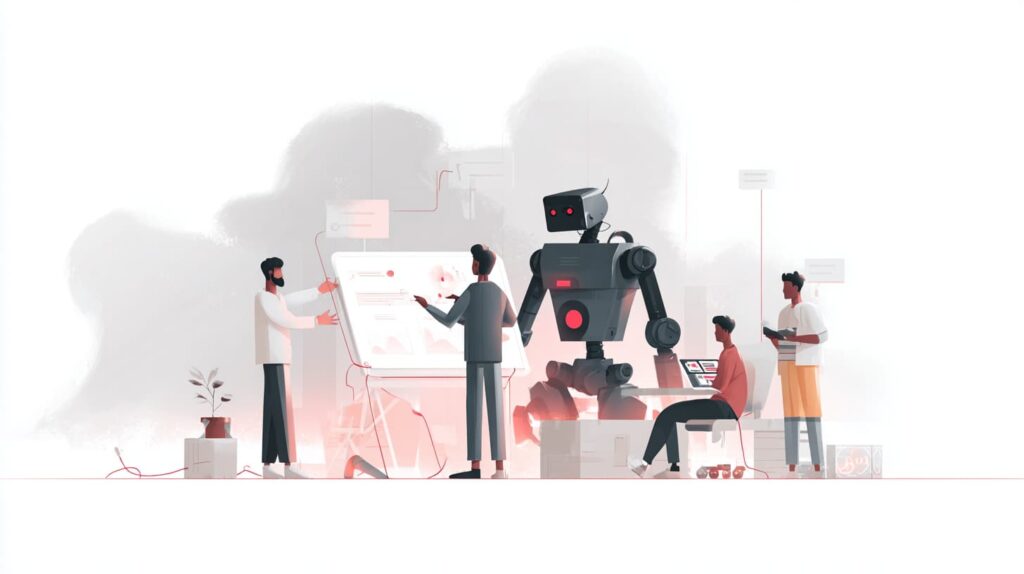By EloInsights, in collaboration with Marcos Navarini
- Transformation should be seen as a continuous cycle that helps keep competitiveness in an organization, involving changes and processes in the approach to technology.
- A TAM approach, which brings together technology, analytics and management, can provide a more complete vision for overcoming barriers and obstacles.
- We have listed 10 actions and points of view that consider the creation of purpose and solid foundations to make transformation processes continuous, in the same step as the world around us.
Transformation is the act of changing something from a first state to a final state. However, in the business world, the definition is a bit more complex than the one in the dictionary.
Transformation involves a set of fundamental changes – in processes, people and technologies. In a company as a whole or in specific areas, all transformations effectively seek to sustain the level of competitiveness, whether through growth, the creation of new organizational capabilities or both.
Naturally, each transformation is different. We believe there are four imperatives to motivate them:
- Extracting Value: which relates to doing more without wasting resources;
- Expanding Value: whether it is acquiring new customers, exploiting new channels or creating new operational levers;
- New Value: the development of new products and services; and
- Redefining Value: by expanding operations in new businesses or new business models, effectively changing the value equation.
One transformation with a specific DNA, result of the combination of several dimensions, is Digital Transformation. It has been driven by the Covid-19 pandemic and the mass take-up of the home office. We can define this phenomenon as the process of using digital technologies to create or change existing business processes, culture and customer experience to meet the market and business requirements of an ever-changing world.
The fact is that no company can survive in the long term unless it is constantly reinventing itself. But it is also true that successful transformations are usually the exception and, often, deliver less than promised.
Why do transformations fail?
Human nature is resistant to change, which makes any transformation difficult. According to John Kotter, professor emeritus at Harvard Business School and an authority on the subject, there are eight main mistakes that jeopardies the entire process. These are: lack of a sense of urgency; absence of a powerful coalition; poor transparency; failure to communicate the vision of the future; maintaining obstacles to the transformation; absence of short-term goals and gains; hasty conclusion of the process; and shallow roots of a new corporate culture.
Even though Kotter published this list 30 years ago, it is still very up to date. Without a fundamental purpose, clarity to communicate and inspire or buy-in from the leadership, it will be difficult to embrace the mechanisms to make change happen.
On long trajectories, it is important to achieve quick wins in the short term. Lean planning and an experimental approach using agile methodologies and short cycles increase the engagement of the entire company and, so, the chances of success. Having solid foundations guarantees better adaptation to constantly changing internal and external scenarios, as well as fueling the renewal of skills for new transformations.
Good leadership encompasses different perspectives and areas of knowledge. We believe that an integrated approach – which can be summarized by the term TAM (Technology, Analytics and Management) – guarantees the application of multiple simultaneous and complementary lenses to solve problems.
Based on the discussions pointed out so far, we have listed 10 actions and points of view to guide a successful transformation:

1. Found out purpose
The purpose sets a direction for change. Before starting the journey, it is extremely important to outline the main goals and assess what barriers may block them, as well as making a connection with the transformations that affect the world and are centered on people and society. Defining goals is crucial, as they pragmatically determine what results are expected and how they will be achieved.
You need to create a transparent message that is assertively conveyed to engage and affect as many employees as possible in understanding these goals and overcoming the obstacles to transformation. Kotter even lays down a rule to help you discover your purpose: you must be able to explain your vision in five minutes, so that someone else understands and remains interested.
2. Eyes to the future and paradigms’ breaking
Be predictive, anticipate and do not limit yourself to traditional thinking. When faced with a problem, you must question the rules of the game and take a challenging stance when thinking about practical solutions, even if they may seem far removed from the organization’s current reality.
Innovation is a lever to guarantee growth and the ability to see new opportunities for creating value. This look to the future must be a lens through which to analyze your transformation purpose. To understand business needs and possibilities that do not exist yet, the organization must combine analytical and deterministic thinking, which we can call more traditional, with future-back thinking, which is more creative and associative.
This means thinking of a macro-objective to be achieved in the future – let’s put it between five and ten years – and, starting from what you want to be, going back in time, thinking of long, medium and short-term goals and horizons to reach the main point. In order not to hinder development in the present, this vision for what is to come involves a set of actions: defining the main goal, developing an extensive action plan, as well as constantly analyzing the market and the results that are being achieved.
The future-back needs to be connected to the company’s strategy through a dual aspect transformation that combines current actions with those that need to be transformed in the adoption of a new operating model. The concept of Dual Transformation, which gives its name to the book by authors Scott Anthony, Clark Gilbert and Mark Johnson, explains this dynamic.
It consists of an “A” transformation, which strengthens and reinvents the main operating model, guaranteeing the company’s current needs, in parallel with a “B” transformation, that develops the core business that will be created going forward. In this way, the company manages to break paradigms, innovate and diversify its activities while dealing with current demands.

3. Pull the right lever
You must find the lever that can “move the dial”. Regardless of the scope of the transformation – whether it is a process improvement or the creation of a new business strategy – only two levers of results will ever be affected.
The first one is revenue growth through attracting new customers, creating new revenue lines, generating competitive differentiators, etc. The second is to improve the Return on Invested Capital (ROIC) by improving the efficiency of operations, optimizing the value equation. In the end, whatever the lever, if it does not have an impact on the company’s cash flow, it will not generate value.
One of the main drivers for recognizing the financial levers that will be achieved is precisely the concept of the Transformation Imperative, explained earlier. Value extraction transformations are essentially about improving ROIC, capturing efficiency gains. Value expansion and the creation of new value are the promotion of revenue growth. Redefining value, on the other hand, means significantly restructuring the company’s value equation along a new growth path.
It is a way of discovering not only the strategic momentum of the company and its neighboring sectors, but also the priority lever that will drive the trajectory of change.
4. Create an environment of transformation
Building a coalition network committed to change unblocks barriers to transformation. It is essential to understand people and find out which triggers will ignite a sense of change in each one involved, understanding interests – both individual and collective – as well as what motivates them to do what they do and what skills need to be developed.
Some elements can accelerate the breaking down of these barriers, such as a bottom-up approach, in which the focus is not just on the highest positions in the organization, but also considers managers and team leaders, as they are the ones who have a direct impact on how projects are carried out and how people are led. In this way, it is possible to find nudges: changes in context that can drive and change behavior, as an incentive for people to embrace transformation more easily.
This analysis of the psychological context, together with good use of communication channels, makes it possible to impact most employees, forming a powerful alliance in driving change. In addition, it is extremely important for the organization to resolve problems and obstacles to allow the change to flow, whether in relation to bureaucratic processes or even the replacement of leaders who are not committed to the change.
5. Manage the transformation
Change management goes beyond communicating the purpose. It must overcome the status quo to materialize the vision of the future desired by the transformation, in the shortest possible time to mitigate the first negative impacts that aversion to change often causes in people. Support the entire process, plan the stages, train people, check and measure the results with active governance. With this, in addition to a smoother journey for those involved, there is greater delivery of value in less time.
The leadership must be deeply committed and aligned, investing efforts in building people’s skills and training, cutting barriers and obstacles, implementing each necessary step and measuring the results to prove that the change is happening. Measuring and evaluating progress has a major impact on the motivation and credibility of the entire transformation journey. Planning and creating short-term victories, quick wins, makes people see the results generated and continue to believe in the purpose.
6. Experiment quickly
It is a fact that the world is changing faster and faster, and that changes in the market are also happening at a very rapid pace. Therefore, adapting to this speed, generating maximum learning at minimum cost and quickly capturing value, keeps a company competitive. A top-down management model, centralized in top management, often influenced by their own experiences or intuition, makes the process considerably slower, more bureaucratic and more hostile to innovation.
The counterpoint lies in the culture of experimentation. When well-structured and carried out on a large scale, this is a great tool for predicting failures and reducing costs. Carrying out analyses together, in a portfolio of experiments, helps deal with failures and mitigates risk aversion – two characteristics of the test and learn culture. After all, when there are more tests, there will also be failures and unproven hypotheses. When decisions no longer depend solely on top management, they become part of various business areas and are taken more assertively and quickly.

7. Do not build a house of cards
Look carefully at the capabilities needed to make transformation possible and make sure they already exist. Without building strong foundations of support, the changes will not be permanent and effective. This preparation stage involves people, systems and processes that will have to adapt to the new reality and is one of the critical points for a successful journey. By recognizing and making adaptations considering the organization’s current ability, a support mechanism is created, preventing steps and targets from being missed.
Investing in training people, building competences and developing leaders who are compatible with the desired transformation, bearing in mind the reality to be established, are essential points for solidifying the foundations and giving continuity to the full process.
8. Let go of the past
One of the stages of change management is to burn the bridges with the past so that there is no return to the earlier context. It is common to consider that change cannot be undone or that the process is fully successful as soon as the first results are obtained. However, if the new dynamics and tools are not rooted and well structured, there will be a strong tendency for people to revert to old habits as soon as they feel less pressurized.
The management change work does not end after the implementation stage. It will still be necessary to define a decommissioning plan for the previous model and incorporate transformation discipline into the various company structures that have been impacted. The organization’s new routines need to take root and the old bridges need to be made inaccessible.
9. Evaluate the transformation
Data must prove that progress is being made in the right direction. When the planning of goals and aims is not aligned with the strategic vision, there is an elevated risk that they will end up going astray – either because they fail to measure and evaluate where they are going or because those involved are demotivated and unable to recognize the value of their efforts.
OKRs (Objectives and Key Results), goals focused on outcomes, show whether the direction is correct. KPIs (Key Performance Indicators) show current performance. Using these metrics together, within a logic of experimentation, makes it possible to evaluate each stage and regulate the expectations of the leadership, making each action tangible.
This has a major impact on ensuring buy-in from the stakeholders involved, it increases both the engagement of those who are interested in checking the process and the motivation for the achievements of the individuals directly involved in its execution. There is a gain in credibility and traction at every stage of the journey.

10. Unlock metatransformations
Creating solid foundations unlocks the capacity for self-transformation. Metatransformation creates the conditions for triggering future transformations in the organization, enhancing change in a continuous cycle. To do this, it is essential to build up knowledge on key subjects and have access to tools, as well as a wide range of methodologies aimed at analytics, experimentation and agile. A culture of continuous learning encourages the constant evaluation and discussion of new practices and the adoption of innovative technologies, reshaping traditional ways of working.
This building of skills and capabilities allows the organization to work on transformation as a journey, in a process that recycles itself and is therefore permanent. The modern organization is driven by change to remain competitive. Only the adoption of practices that favor this new mindset, shaped by autonomy in problem solving, will make a company capable of self-transformation, engaging in transformation processes and keeping pace with the constant changes in the world around it.
MARCOS NAVARINI works as Senior Consultant at EloGroup.











